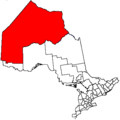
The Cree are a North American Indigenous people. They live primarily in Canada, where they form one of the country's largest First Nations.
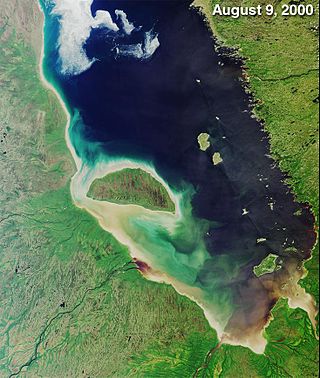
James Bay is a large body of water located on the southern end of Hudson Bay in Canada. It borders the provinces of Quebec and Ontario, and is politically part of Nunavut. Its largest island is Akimiski Island.
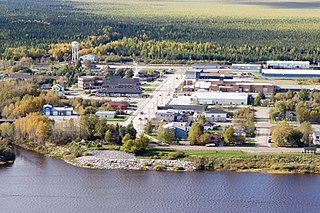
Moosonee is a town in northern Ontario, Canada, on the Moose River approximately 19 km (12 mi) south of James Bay. It is considered to be "the Gateway to the Arctic" and has Ontario's only saltwater port. Nearby on Moose Factory Island is the community of Moose Factory to which it is connected by water taxi in the summer and ice road in the winter.
In Canada, an Indian reserve is defined by the Indian Act as a "tract of land, the legal title to which is vested in His Majesty, that has been set apart by His Majesty for the use and benefit of a band." Reserves are areas set aside for First Nations, one of the major groupings of Indigenous peoples in Canada, after a contract with the Canadian state, and are not to be confused with Indigenous peoples' claims to ancestral lands under Aboriginal title.
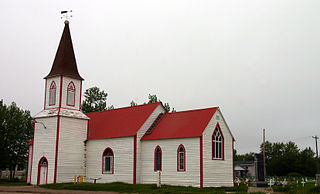
Moose Factory is a community in the Cochrane District, Ontario, Canada. It is located on Moose Factory Island, near the mouth of the Moose River, which is at the southern end of James Bay. It was the first English-speaking settlement in lands now making up Ontario and the second Hudson's Bay Company post to be set up in North America after Fort Rupert. On the mainland, across the Moose River, is the nearby community of Moosonee, which is accessible by water taxi in the summer, ice road in the winter, and chartered helicopter in the off-season.

Fort Albany First Nation is a Cree First Nation in Cochrane District in Northeastern Ontario, Canada, within the territory covered by Treaty 9. Situated on the southern shore of the Albany River on the west coast of James Bay, Fort Albany First Nation is accessible only by air, water, or by winter road.
Neskantaga First Nation is a remote Oji-Cree First Nation band government in the northern reaches of the Canadian province of Ontario, situated along the shore of Attawapiskat Lake in the District of Kenora.

The Kashechewan First Nation is a Cree First Nation band government located near James Bay in Northern Ontario, Canada. The community is located on the northern shore of the Albany River. Kashechewan First Nation is one of two communities that were established from Old Fort Albany in the 1950s. The other community is Fort Albany First Nation, which is now located on the southern bank of the Albany River. The community is connected to other towns along the shore of James Bay by the seasonal ice road/winter road, linking it to the towns of Attawapiskat, Fort Albany, and Moosonee.
Peawanuck is an isolated Cree community in the Kenora District, Ontario, Canada. It is located near the confluence of the Winisk and Shamattawa rivers, about 35 km from the Winisk River's end in Hudson Bay. Its population is 237.
Kitchenuhmaykoosib Inninuwug, also known as Big Trout Lake First Nation or KI for short, is an Oji-Cree First Nation reserve in Northwestern Ontario and is a part of Treaty 9. The community is about 580 km (360 mi) north of Thunder Bay, Ontario.

Nishnawbe Aski Nation is a political organization representing 51 First Nation communities across Treaty 9 and Treaty 5 areas of Northern Ontario, Canada. Re-organized to its present form in 1981, NAN's original objective was "to represent the social and economic aspirations of our people at all levels of government in Canada and Ontario until such time as real effective action is taken to remedy our problems."
Weenusk First Nation is a Cree First Nation band government in the Canadian province of Ontario. In September, 2007, its total registered population was 516. Weenusk First Nation was an independent member of the Nishnawbe Aski Nation (NAN) but now have joined the Mushkegowuk Council, a regional tribal council, who is also a member of NAN.
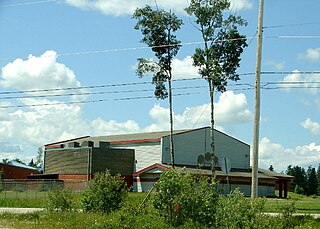
Constance Lake First Nation is an Oji-Cree First Nations band government located on the shores of Constance Lake near Hearst, Cochrane District in northeastern Ontario, Canada. It is directly north of the community of Calstock along a continuation of Ontario Highway 663. Constance Lake First Nation is home to close to 1605 members of Cree and Ojibway with approximately 820 living on reserve. The reserves, Constance Lake 92 and English River 66, total 7,686 acres (3,110 ha) in size.
Cross Lake First Nation is a band of Cree First Nations people in Canada governed under the Indian Act. Its members occupy several reserves within the town of Cross Lake situated on the east shore of Cross Lake in the province of Manitoba. In October 2008, its recorded registered membership was 6,969, of which 4,953 people of this First Nation lived on their reserve. Cross Lake is the principal community of the Pimicikamak indigenous people that made treaty with the British Crown in 1875. Its indigenous language is Woods Cree. Cross Lake was the site of a residential school operated under Canada's assimilation policy. In 2008, Prime Minister Stephen Harper apologized for the damage caused by this policy.
The Victor Mine was the first Canadian diamond mine located in Ontario, and De Beers' second diamond mine in Canada. It is located in the Northern Ontario Ring of Fire, in the James Bay Lowlands 90 kilometres (56 mi) west of Attawapiskat in the remote northern part of the province. In June 2005, the Attawapiskat First Nation voted in favour (85.5%) of ratifying the Impact Benefit Agreement (IBA). Construction of the mine began in February 2006 which created 3200 positions; mining and operations will create around 400 permanent positions. The Victor Mine is an open-pit mine, with a processing plant, workshops, and an airstrip located on site. By 2013–2014 royalties collected from De Beers Victor Mine amounted to $226. At that time De Beers was continuing to pay off its "$1 billion investment to build the mine and from now until it closes, the company expects to pay tens of millions of dollars in royalties." The mine completed mining and processing in 2019 and has moved to a shut-down phase including demolition of infrastructure and rehabilitation of the site.
The Ring of Fire is a vast, mineral-rich region located in the remote James Bay Lowlands of Northern Ontario, Canada. Spanning approximately 5,000 square kilometres (1,900 sq mi), the area is rich in chromite, nickel, copper, platinum group elements, gold, zinc, and other valuable minerals. Discovered in the early 21st century, the Ring of Fire is considered one of the most significant mineral deposits in Canada, with the potential to greatly impact the nation's economy and global mining industry. The development of this region has been a subject of ongoing debate, as stakeholders weigh the economic benefits against environmental concerns and the rights of Indigenous communities in the area. Despite these challenges, the Ring of Fire had remained a focal point for the Canadian mining sector and government, as well as international investors. By July 2023, the federal and provincial governments were no longer in agreement on priorities for federal funding of the Ring of Fire. Georgia Lake lithium project, KGHM's Victoria mine proposal and the Onaping Depth nickel project—which will produce minerals required for the low carbon economy—had become higher priorities, particularly as the Ring of Fire project is situated in a region of "vast, environmentally sensitive...peatlands".
The Mathias Colomb Cree Nation (MCCN) —also known as Mathias Colomb First Nation, Mathias Colomb (Cree) First Nation, and Pukatawagan/Mathias Colomb Cree Nation—is a remote First Nations community in northern Manitoba, located 210 km (130 mi) north of The Pas and 819 km (509 mi) northwest of Winnipeg, Manitoba.

Shannen's Dream is a Canadian youth-driven movement advocating for equitable education funding for First Nations children. Education on-reserve is funded by the Government of Canada, while off-reserve education is funded by provincial or territorial governments. Several reports by the Auditor General of Canada, the Parliamentary Budget Officer, and other authorities have indicated an urgent need for improved funding for on-reserve education. Shannen's Dream advocates for the building of safe and comfy schools on reserves, and culturally based education for all First Nations children and youth. The movement was named in honour of Shannen Koostachin, a young activist from the Attawapiskat First Nation and a nominee for the 2008 International Children's Peace Prize
Theresa Spence is a former chief of the Attawapiskat First Nation in Canada. She was a prominent figure in the Attawapiskat housing and infrastructure crisis, Idle No More, and other First Nations issues. Prior to serving as chief, she was the deputy chief of Attawapiskat.
Midnight Shine is a Canadian roots-rock band from Northern Ontario and Manitoba, consisting of lead vocalist/guitarist Adrian Sutherland, bassist/vocalist Stan Louttit, guitarist/vocalist Zach Tomatuk and drummer Charnelle Menow. They have released three studio albums and three music videos and have been actively touring across Canada since 2016.














